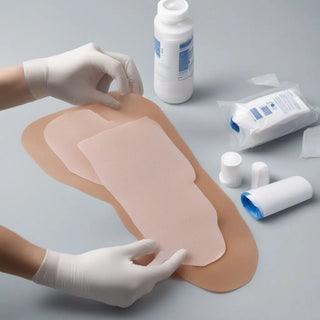Allowing an ulcer to dry out impedes the healing process. Maintaining a moist environment has been shown to improve healing rates compared to dry ulcers (1). There are a variety of dressing that can assist with maintaining the optimal moisture and environment for wound healing. Some methods to optimize a moist wound environment include:
- Hydrogel dressings that promote moist wound bed
- Hydrocolloid dressings that absorb exudate
- Foam dressings that maintain moisture
- Topical emollients if ulcer is dry
- Covering ulcer with semi-permeable film dressing
Controlling Pressure and Swelling
Excess pressure on an ulcer further damages tissue and restricts blood flow. Steps to offload pressure:
- Redistribute body weight with special mattresses and cushions (2)
- Use appropriate casting, bracing or orthotics to avoid putting pressure on ulcer
- Limit time bearing weight on ulcer - use ambulation aids
- Elevate affected limbs to reduce swelling
- Apply compression bandages or garments if vascular insufficiency
Statistics on Chronic Ulcers
- The most frequent ulcers are venous leg ulcers, diabetic foot ulcers, arterial ulcers and pressure ulcers (3)
- Venous leg ulcers affect 600,000-1 million people in the US annually (4)
- Diabetic foot ulcers affect 15-25% of people with diabetes in their lifetime (5)
Nutrition and Supplements
Optimal ulcer healing requires proper nutrition and key nutrients:
- Increase protein intake - supports tissue growth and collagen synthesis (6)
- Vitamins A, C and zinc - aid cellular repair and fight infection
- Hydration is vital - dehydration slows healing
- Consider supplements like Condition Direct Healing Support with zinc, vitamin C and antioxidants
Other Contributing Factors
Additional considerations for comprehensive ulcer management:
- Control blood glucose levels for diabetic ulcers
- Improve circulation and oxygenation
- Debride devitalized tissue - stimulate growth of healthy tissue
- Prevent and treat infections
- Manage pain and stress that disrupt healing
- Apply advanced dressings and treatments
A holistic approach addresses all aspects that impact healing - moisture balance, pressure relief, nutrition, and other individual factors based on ulcer type and health status. This facilitates optimal ulcer closure and recovery.
Disclaimer: This article is for general information only, not medical advice. Discuss prevention and treatment with your health provider.
References
- Leaper, D. J., & Durani, P. (2008). Topical antimicrobial therapy of chronic wounds healing by secondary intention using iodine products. International Wound Journal, 5(2), 361-368.
- Padula, W. V., Delarmente, B. A., Messer, M. A., Murphy, J. D., Eisenhauer, C. M., & Mishra, M. K. (2019). Preventing pressure injuries among hospitalized patients: The pressure ulcer prevention study. Journal of Nursing Care Quality, 34(3), 205-212.
- Hess, C.T. (2011). Types of Chronic Wounds. In Chronic Wounds: Advanced Management Concepts, 24-56.
- OʼMeara, S., Cullum, N., Nelson, E. A., & Dumville, J. C. (2012). Compression for venous leg ulcers. The Cochrane database of systematic reviews, 11(11), CD000265.
- Singh, N., Armstrong, D. G., & Lipsky, B. A. (2005). Preventing foot ulcers in patients with diabetes. JAMA, 293(2), 217–228.
- Demidova-Rice, T. N., Hamblin, M. R., & Herman, I. M. (2012). Acute and impaired wound healing: pathophysiology and current methods for drug delivery, part 1: normal and chronic wounds: biology, causes, and approaches to care. Advances in skin & wound care, 25(7), 304–314.
Stay tuned for more insightful content on the role of nutrition in health and healing from Condition Directed Supplements.
